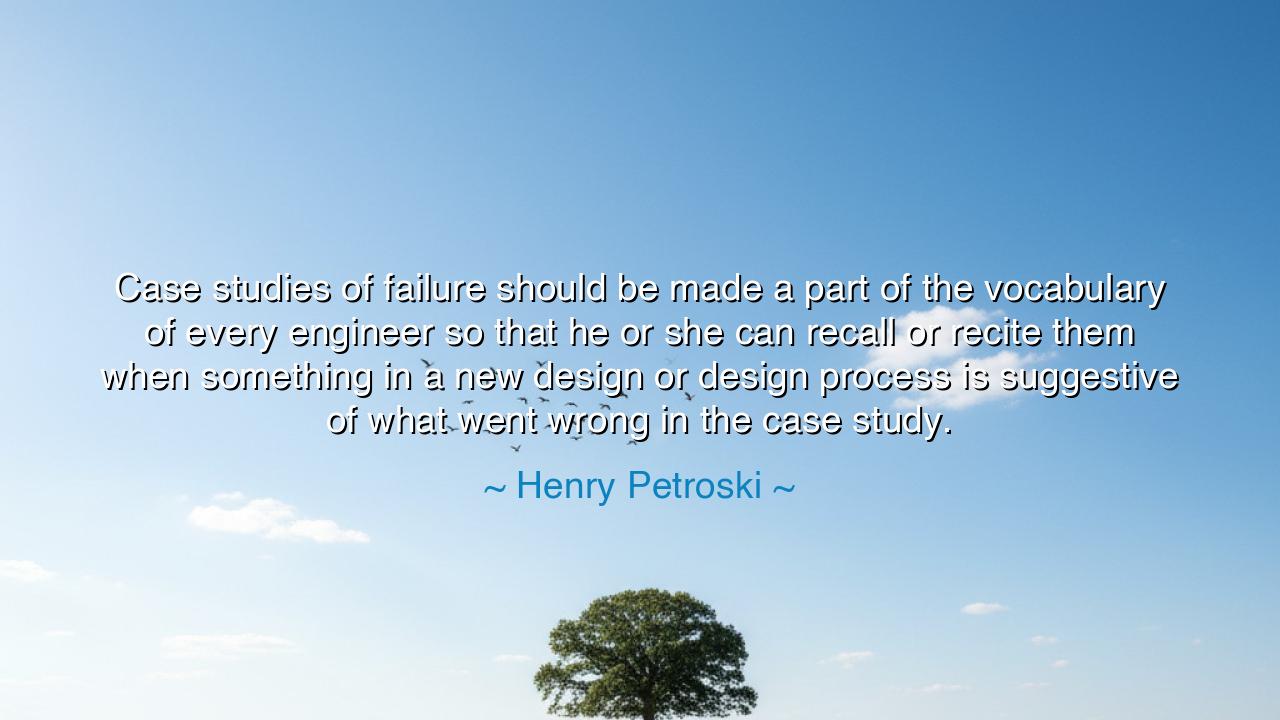
Case studies of failure should be made a part of the vocabulary
Case studies of failure should be made a part of the vocabulary of every engineer so that he or she can recall or recite them when something in a new design or design process is suggestive of what went wrong in the case study.






“Case studies of failure should be made a part of the vocabulary of every engineer so that he or she can recall or recite them when something in a new design or design process is suggestive of what went wrong in the case study.” – Henry Petroski
Hear these words, O students of craft and builders of tomorrow, for they are the wisdom of Henry Petroski, a modern philosopher of engineering and failure. In this quote, he speaks not merely to the engineer’s mind, but to the soul of all who create. He teaches that failure is not an enemy but a teacher, that the memory of what has fallen is the foundation upon which lasting things are built. To understand this, one must abandon pride and embrace humility—for the path to mastery is paved not with triumphs alone, but with the ruins of what once broke and taught us why.
Petroski’s insight rises from the long tradition of those who dared to design, who sought to bring order to the elements. From the builders of bridges and towers to the architects of machines and code, all who create dance with risk. Yet it is not the perfection of their successes that defines them, but their remembrance of failure. The wise builder studies collapse as the physician studies disease—not with shame, but with reverence. For every broken beam, every fallen structure, every shattered dream hides within it the seed of wisdom, waiting to be understood.
Consider, for example, the story of the Tacoma Narrows Bridge, known to history as Galloping Gertie. Built with elegance and ambition, it stretched across the waters of Washington State—a marvel of design. Yet, in 1940, mere months after its opening, it collapsed in a graceful, terrifying dance, torn apart by winds its engineers had underestimated. The tragedy was not in its fall, but in the lesson it left behind: the need to account for resonance, for flexibility, for the unseen harmony between nature and structure. From that failure arose new principles of design, and every bridge built thereafter carried the memory of Tacoma within its steel and soul. Thus, as Petroski commands, the case study of failure became a part of the engineer’s sacred vocabulary.
What Petroski truly calls for is the remembrance of imperfection. Too often, the young creator dreams only of innovation, blind to the ghosts of the past. But wisdom, he teaches, is not in invention alone—it is in awareness. The engineer who remembers the stories of disaster guards against repeating them. Just as the ancient mariners marked the reefs where ships had perished, so too must the modern designer mark the failures that have come before, so that their own vessels may sail safely through the storms of creation.
There is also a deeper philosophy here—one that transcends engineering. For life itself is an act of design. Each decision we make, each structure we build in the heart or mind, carries with it the risk of collapse. To study our failures, to recall them not with despair but with discipline, is the path of the wise. The fool hides his mistakes; the sage studies them. The fool curses his fall; the sage learns how to rise. And so, Petroski’s words speak not only to the engineer’s hand, but to every soul that seeks to build something enduring in this world.
In the spirit of the ancients, let us then turn failure into scripture. Let the archives of collapse and error be treated as sacred texts—not to shame, but to guide. Let every bridge that fell, every experiment that faltered, every plan that failed to hold weight, become a parable for those who follow. For the ancients, too, honored such memory: the Romans carved their errors into stone, the scholars of Alexandria catalogued their miscalculations, and even the builders of cathedrals left behind marks of imperfection, lest their works claim to rival the divine.
The lesson, therefore, is clear: to build wisely is to remember deeply. Do not seek to erase failure, for it is your greatest mentor. Study it, speak of it, and pass it down to those who come after. Let its story dwell not in shame but in reverence. In every design, in every act of creation, whisper the names of what once fell—so that what you build may stand firm.
And so, children of invention, take this teaching to heart: learn not only from success, but from the wreckage of what went wrong. For in that remembrance lies safety, and in that humility lies greatness. The true engineer, the true creator, is not the one who never fails—but the one who knows why failure came, and who, through knowledge, builds a bridge that will never fall again.






AAdministratorAdministrator
Welcome, honored guests. Please leave a comment, we will respond soon